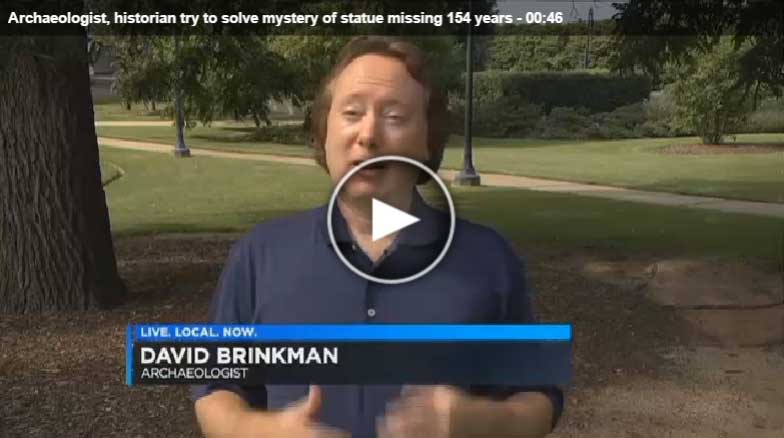HistorySoft in the news:
Archaeologist, historian try to solve mystery of statue missing 154 years
WIS-TV: By Renee Standera
WIS-TV Story and video link is here

COLUMBIA, SC (WIS) -
A
historic statue of John C. Calhoun survived the shipwreck that brought
it to this continent, but a local archaeologist and historian are
trying to determine if it survived the ravages of Sherman's Army when
it marched through Columbia.
"I actually came across a photo of
the statue," said David Brinkman. "Here's this, it's like a Roman
statue, a toga, and that it's John C. Calhoun and it was burned in the
burning of Columbia, you know? Destroyed. Lost. And so that really got
my fascination with it."
It was commissioned by the City of Charleston in 1844 by noted American sculptor Hiram Powers.
The
7-foot statue was such an icon, its image was used on six different
pieces of currency, including the Merchants Bank of Cheraw. Because of
Calhoun's political views, it was also a symbol of what the Union Army
was fighting against.
"The Union did not like Calhoun," Brinkman
said. "They did not like images of him. So they would have loved an
opportunity to destroy an image of him if they ever came across it. So
we kind of felt like that's probably not what happened but we wanted to
get more details on it."
But was the statue lost in the Columbia
fire in February 1865? That's what Brinkman is trying to determine. He
has spent years investigating archaeological sites in the Columbia
area, including Fort Granby in Cayce.
"All accounts say it was moved to Columbia where it was destroyed," he said. "How come there are no pieces of it?"
Brinkman
believes the statue may be buried under the grounds of the South
Carolina State House. Particularly drawing the attention of the Union
troops, the old State House burned in the fire of 1865.
"The
building burned, collapsed." Brinkman said. "That would have all filled
in...anything that was in that building could still be in the bottom of
the basement hole."
Powers shipped the statue from his studio in
Italy to Charleston in 1850. But en route to the US, the ship carrying
the statue sank off the coast of Long Island. According to Brinkman's
research, the sinking of the Elizabeth inspired the Elizabeth Barrett
Browning's poem Aurora Lee. Three months later, the statue was located
and retrieved and sent on its way to Charleston, where it would be
displayed in City Hall and it was last reported being seen.
"When
you do history research you start coming across all these little facts
and they start filling up your head and puzzles begin to come
together," Brinkman said.
To protect the statue as General
William Tecumseh Sherman's Union Army approached South Carolina,
Brinkman said a book written by Charleston Art Historian Anna Wells
Rutledge reports the statue was shipped to Columbia for safekeeping.
"The
book says the statue was moved to the Old State House," Brinkman said.
"Now, Tom (Elmore) has pointed out maybe they meant the Old State House
in Charleston."
"It's still kind of a mystery,"Brinkman said.
"It could be at the depot, it could be at the Old State House, could be
the old Capitol Building, which was also mentioned."
Brinkman
has been collaborating with Columbia historian and author Tom Elmore,
who has researched extensively the Union Army's path through South
Carolina.
"Dave asked me if I ever came across any references to
the Calhoun statue and I went back to my voluminous notes...looking at
the civilian accounts and Union accounts and basically came up empty,"
Elmore, who said he found no references from Union soldiers about
seeing the statue in Columbia.
"With Tom's theory, it was moved
at the last minute to--and it probably came into the railroad depot
here in Columbia, in which case, there may have not been anyone to move
it," Brinkman said.
That depot was where Wet Willies is today in the Vista. It, too was destroyed in February 1865.
"I
think it was never uncrated because it was just too awkward, too
heavy," Elmore said. "And I think the people of Charleston thought it
was just being kept here for safekeeping and not put on display, so
when the freight yard blew up, so did the statue."
Despite
Elmore's theory, Brinkman wants to conduct archaeological research on
the site of the old State House. Part of his investigation is knowing
exactly where the building was, which is not where a stone currently
stands to mark the site. Brinkman said the building also was moved
slightly to make room for construction of the current State House.
"There's
a lot of evidence on exactly where the old State House was located," he
said. "The only place I think it could be found is if it was in the old
State House, in the basement and the Union Army somehow or other didn't
know about it."
"At the time of the war, it was probably revered
by South Carolinians much in the same way that we, today, revere the
Statue of Liberty," said Elmore.
A miniature Parian ware statue
is in the collection of the Gibbs Art Museum in Charleston. Brinkman
also tracked down a bust, possibly made from a cast of the statue, in
the North Carolina Museum of Art.
"I think if you were to find it today, it would be huge news in the art world," Brinkman said.
Click here to read Brinkman's extensive research.
Click here to see images Brinkman compiled in 3-D.
Copyright 2016 WIS. All rights reserved.
